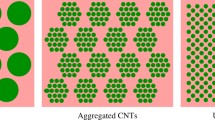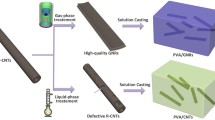Abstract
Pure chitosan and carbon nanotube (CNT)/chitosan nanocomposite films were fabricated via a sublimation-drying process at −196 °C, during which polymeric repulsion generates unique pores with multi-layered structures. The films were then transformed into multi-layered and vertically aligned multi-layered (VAM) structures by compression. Due to the cross-linking between layers, the films prepared at −196 °C showed significantly better mechanical properties than the films prepared at −78 and −20 °C. Furthermore, a peculiar phenomenon was observed in that pure chitosan which exhibited better mechanical properties than the nanocomposites. To explain these results, we suggest a model in which the VAM structure supports more load than the CNT fillers.





Similar content being viewed by others
References
Curtin WA, Sheldon BW (2004) CNT-reinforced ceramics and metals. Mater Today 7:44–49
Salvetat JP, Bonard JM, Thomson NH, Kulik AJ, Forr´o L, Benoit W, Zuppiroli L (1999) Mechanical properties of carbon nanotubes. Appl Phys A 69:255–260
Hou Y, Tang J, Zhang H, Qian C, Feng Y, Liu J (2009) Functionalized few-walled carbon nanotubes for mechanical reinforcement of polymeric composites. ACS Nano 3:1057–1062
Balasubramanian K, Burghard M (2005) Chemically functionalized carbon nanotubes. Small 1(2):180–192
Harris PJF (2009) Carbon nanotube science: synthesis, properties and applications. Cambridge University Press, Cambridge
Park JH, Alegaonkar PS, Jeon SY, Yoo JB (2008) Carbon nanotube composite: dispersion routes and field emission parameters. Compos Sci Technol 68:753–759
Harrison BS, Atala A (2007) Carbon nanotube applications for tissue engineering. Biomaterials 28:344–353
Liu Y, Wang M, Zhao F, Xu Z, Dong S (2005) The direct electron transfer of glucose oxidase and glucose biosensor based on carbon nanotubes/chitosan matrix. Biosens Bioelectron 21:984–988
Liu Y, Liu L, Dong S (2007) Electrochemical characteristics of glucose oxidase adsorbed at carbon nanotubes modified electrode with ionic liquid as binder. Electroanal 19(1):55–59
Xie F, Weis P, Chauvet O, Bideau JL, Tassin JF (2010) Kinetic studies of a composite carbon nanotube-hydrogel for tissue engineering by rheological methods. J Mater Sci-Mater Med 21:1163–1168. doi:10.1007/s10856-009-3984-x
Zhang M, Smith A, Gorski W (2004) Carbon nanotube–chitosan system for electrochemical sensing based on dehydrogenase enzymes. Anal Chem 76:5045–5050
Sun F, Cha HR, Bae K, Hong S, Kim JM, Kim SH, Lee J, Lee D (2011) Mechanical properties of multilayered chitosan/CNT nanocomposite films. Mater Sci Eng, A 528:6636–6641
Sun F, Lim BK, Ryu SC, Lee D, Lee J (2010) Preparation of multi-layered film of hydroxyapatite and chitosan. Mater Sci Eng, C 30:789–794
Lucas BN, Oliver WC (1999) Indentation power-law creep of high-purity indium. Metall Mater Trans A 30:601–610
Oliver WC, Pharr GM (1992) An improved technique for determining hardness and elastic-modulus using load and displacement sensing indentation experiments. J Mater Res 7:1564–1583
Acknowledgements
This research was co-supported by (1) the Basic Science Research Program through the National Research Foundation of Korea (NRF) funded by the Ministry of Education (NRF-2010-0025175), (2) a grant from the Fundamental R&D Program for Core Technology of Materials funded by the Ministry of Trade, Industry & Energy, Republic of Korea, (3) the Civil & Military Technology Cooperation Program through the National Research Foundation of Korea (NRF) funded by the Ministry of Science, ICT & Future Planning (No. 2013M3C1A9055407).
Author information
Authors and Affiliations
Corresponding authors
Additional information
Minju Oh and Fangfang Sun have contributed equally to this work.
Rights and permissions
About this article
Cite this article
Oh, M., Sun, F., Cha, HR. et al. Vertically aligned multi-layered structures to enhance mechanical properties of chitosan–carbon nanotube films. J Mater Sci 50, 2587–2593 (2015). https://doi.org/10.1007/s10853-015-8826-2
Received:
Accepted:
Published:
Issue Date:
DOI: https://doi.org/10.1007/s10853-015-8826-2




